Potrebujeme váš súhlas na využitie jednotlivých dát, aby sa vám okrem iného mohli ukazovať informácie týkajúce sa vašich záujmov. Súhlas udelíte kliknutím na tlačidlo „OK“.
ASTM E2759-10
Standard Practice for Highway Traffic Monitoring Truth-in-Data
Automaticky preložený názov:
Štandardné praktiky pre Highway Traffic sledovanie Pravdu-in-dát
NORMA vydaná dňa 1.5.2010
Informácie o norme:
Označenie normy: ASTM E2759-10
Poznámka: NEPLATNÁ
Dátum vydania normy: 1.5.2010
Kód tovaru: NS-45989
Počet strán: 5
Približná hmotnosť: 15 g (0.03 libier)
Krajina: Americká technická norma
Kategória: Technické normy ASTM
Kategórie - podobné normy:
Anotácia textu normy ASTM E2759-10 :
Keywords:
base data integrity, traffic monitoring, truth-in-data, ICS Number Code 03.220.20 (Road transport)
Doplňujúce informácie
| Significance and Use | ||||||||||||||
|
There are general references to the principle of truth-in-data as found in Guide E2259 and Practice E2667. While these references are helpful, without clarification differences occur within agencies over time as well as among agencies in how truth-in-data is implemented. In the absence of a standard practice for truth-in-data, documentation in some governmental agencies is neither comprehensive nor consistent. For some organizations, truth-in-data is an exception to common practice and occurs only in response to a specific request to understand a specific traffic data set or summary statistic from a traffic data set. This practice provides consistent approach to truth-in-data implementation. Traffic Monitoring Stages—Traffic monitoring truth-in-data describes how base data are treated at each traffic monitoring stage from field data collection through evaluation, acceptance, summarization and reporting. Benefits—Truth in data provides a means of addressing if and how missing or questionable data are modified as part of data acceptance and use. The benefit arises from understanding what data assumptions or adjustment factors, if any, were applied to reported traffic summary statistics. If an adjustment factor or factors were applied, consistent with truth-in-data the source and adjustment factor source characteristics are disclosed. With this type of information, the data user is in a better position to understand the data set and summary statistics, ask questions, and appropriately apply the data. Truth-in-data ensures that traffic data can be correctly interpreted and appropriately used to improve highway operations safety and efficiency. Exceptions—Traffic monitoring truth-in-data does not address subsequent use of the data and summary statistics as in longitudinal studies. Traffic monitoring truth-in-data establishes the basis for appropriate current and longer-term use of base data and summary statistics. Critical use of traffic monitoring data such as in safety analysis depends on the data clarity and integrity identified by implementing truth-in-data. Traffic monitoring truth-in-data does not address data storage. Traffic monitoring truth-in-data describes the conditions leading to acceptance of data for storage and the reporting of data retrieved from storage. The metadata structure for archived data management systems (ADMS) recommended for traffic monitoring data is presented in Practice E2665. An ADMS is the information management system used to store traffic data with integrity over time. |
||||||||||||||
| 1. Scope | ||||||||||||||
|
1.1 Traffic monitoring truth-in-data is the disclosure of how data are managed from field data collection through evaluation, acceptance, summarization and reporting. Through this disclosure, truth-in-data permits traffic monitoring summary statistics to be recalculated from the base data. 1.1.1 Truth-in-data can be applied in all traffic monitoring programs at all levels of investment and development. Temporary manual field activities and permanent data gathering installations share a common interest in and need for the ability to check and confirm reported traffic statistics. This is the irreducible minimum for both sharing traffic data over time within an agency, and at a point of time and over time among agencies. 1.1.2 Truth-in-data also permits alternative assessment of the base data. The ability to recalculate traffic statistics from base data provides the opportunity to use different assumptions or to apply different adjustment factors. As understanding of traffic data proceeds, truth-in-data permits equivalent longitudinal assessment of traffic summary statistics through consistent adjustment and treatment of base data over a study period. 1.1.3 Truth-in-data is the foundation for all traffic monitoring programs because of its applicability to all traffic monitoring programs, its support of meaningful sharing of data among diverse programs, and its contribution to understanding and applying data for the improvement of traffic management. 1.2 Units—The values stated in inch-pound units are to be regarded as the standard. The values given in parentheses are mathematical conversions to SI units that are provided for information only and are not considered standard. 1.3 This standard does not purport to address all of the safety concerns, if any, associated with its use. It is the responsibility of the user of this standard to establish appropriate safety and health practices and determine the applicability of regulatory limitations prior to use. |
||||||||||||||
| 2. Referenced Documents | ||||||||||||||
|
Podobné normy:
Historická
1.2.2009
Historická
1.11.2009
Historická
1.7.2009
Historická
1.11.2009
Historická
1.7.2012
Historická
1.7.2009


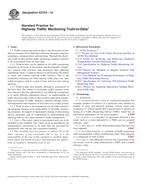
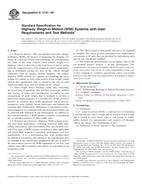 ASTM E1318-09
ASTM E1318-09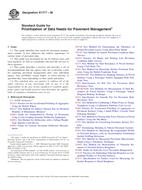 ASTM E1777-09
ASTM E1777-09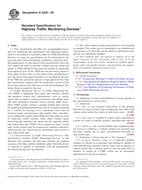 ASTM E2300-09
ASTM E2300-09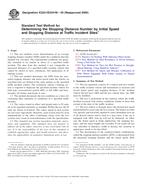 ASTM E2341/E2341M-05..
ASTM E2341/E2341M-05.. ASTM E2467-05(2012)..
ASTM E2467-05(2012)..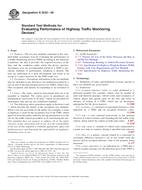 ASTM E2532-09
ASTM E2532-09
 Cookies
Cookies
